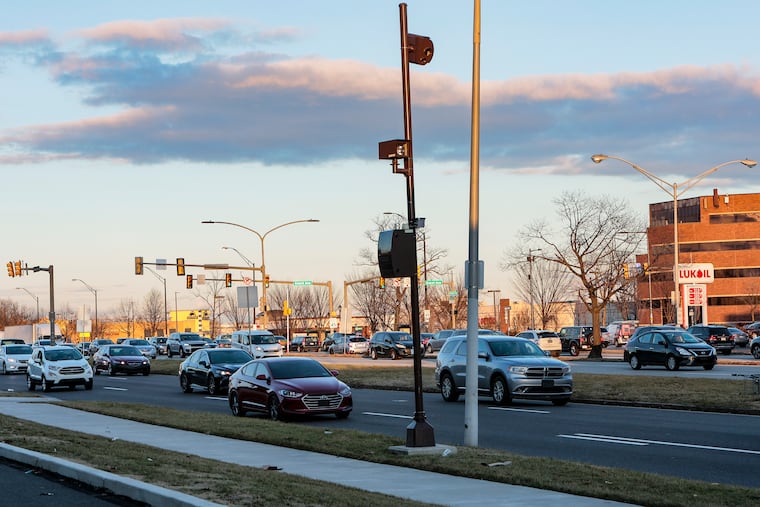Five dangerous Philly roads will get cameras to catch speeders. People are clamoring for them.
Hoping to spark discussion, at-large City Councilmember Isaiah Thomas is conducting a detailed survey of city residents, working with community groups to circulate it.

Philadelphia is preparing for a gold rush.
State legislation enacted last December authorizes the city to set up speed-enforcement cameras on five dangerous traffic corridors, in addition to those already stationed along Roosevelt Boulevard.
Neighborhoods from all directions of the compass have been begging for the technology to fight an epidemic of speeding and aggressive driving that has led to record numbers of crashes with fatalities and serious injuries over the last several years.
“People are always asking me, ‘When are the cameras coming?’ and ‘Where are they going to be put?’ There’s a lot of energy and interest,” said Nicole Brunet, policy director of the Bicycle Coalition, which works on road safety issues.
Hoping to spark discussion, at-large Councilmember Isaiah Thomas is conducting a detailed survey of city residents, working with community groups to circulate it. The survey asks for opinions on automated traffic enforcement and suggestions for where to put cameras.
» READ MORE: Where would you like to see more speed cameras in Philly?
He said in an interview the surveys are meant to be advisory, not a referendum.
“It’s not necessarily about where they recommend, it’s about where they reside,” Thomas said. “We want to make sure we’re hearing from all Philadelphians, and not just the loud minority.”
Thomas, who wrote the 2021 Driving Equality law that limits police stops for minor infractions, said it’s important to make sure that speed cameras are sited in an equitable way so “we’re not unintentionally taxing and penalizing poor communities and communities of color.”
On Roosevelt Boulevard in the Northeast, there were 239 crashes in 2021, compared with 374 in 2019, a 36% decrease, the state’s Transportation Advisory Committee reported last year. Overall, there were 10,463 crashes in Philadelphia in 2021, compared with 11,131 in 2019, a decline of 6%.
In 2021, there were 24 collisions with fatalities or serious injuries on the Boulevard, compared with 27 in 2019, an 11% drop, while at the same time there were 555 serious crashes in the city as a whole in 2021, compared with 479 in 2019, a 16% increase. The committee recommended allowing speed cameras statewide.
That didn’t happen, but lawmakers managed to pass a measure making the Roosevelt Boulevard cameras permanent, instead of an experiment set to expire. The law also authorized the new cameras.
Support for measures to slow traffic, including camera enforcement, has grown in recent years, at least in the city. Many members of City Council say their constituents’ top request is for projects like speed bumps and narrower roads.
Some people and motorist organizations oppose camera enforcement, contending that it’s ripe for abuse and a moneymaker for local governments.
“It’s not a money grab,” State Rep. Ed Neilson (D., Philadelphia), who helped enact the legislation, told attendees at a recent Vision Zero safety conference. “I want you to look at the person next to you. And what do you think that life is worth?”
On Roosevelt Boulevard, the number of tickets issued has steadily declined, as has the number of repeat offenders, according to figures from the Philadelphia Parking Authority, which runs the program.
As of Thursday, at least 864 people had responded to Thomas’ speed-camera survey, said spokesperson Ben Wilcox. Broad Street, especially its northern stretches, seems to be the leading choice so far, he said.
Others include Cobbs Creek Parkway, Kelly Drive, Lincoln Drive, Delaware Avenue, Lehigh Avenue, and Cottman and Aramingo Avenues.
During a Council budget hearing April 9, city transportation officials said they were looking closely at PA 611, which encompasses all of Broad Street, for speed cameras. It is at or near the top of the list of dangerous roadways.
The Office of Transportation and Infrastructure Systems is analyzing crash data to rank corridors. They’re required by the law to consult with the PPA and PennDot; traffic studies must be conducted of the possible roadways.
Council has to pass legislation for each corridor (not each camera) after the three agencies jointly make recommendations.
“Our position has been and always will be to use data on speeding-related crashes to site these cameras,” said Brunet, of the Bicycle Coalition.
Anne Dicker, president of West Mount Airy Neighbors, agrees. She and other residents have been pushing to slow traffic on Lincoln Drive, which, while dangerous, is probably not in the top five, she said.
“Since Philadelphia was only granted five streets to get speed cameras, it’s my hope that the Streets Department will prioritize the most vulnerable street users — pedestrians and cyclists,” Dicker said. “I hope we maximize the number of lives saved and I hope it doesn’t fall prey to political grandstanding.”
Columbus Boulevard, an often terrifying blur of speeding vehicles and a popular course for drag racers, would be a strong candidate, said Louis Bartholomew, executive director of Queen Village Neighbors Association.
“I’m not sure where it stands in the hierarchy of dangerous roadways,” Bartholomew said. The corridor is on the city’s High Injury Network, the 12% of streets that account for 80% of crashes in which people are seriously injured or killed.
“I have my fingers crossed, but ultimately it’s going to be what the data shows,” Bartholomew said.
Queen Village has benefited from traffic calming measures on Washington Avenue, which runs along the neighborhood’s southern border, he said: “It’s more pleasant for everybody.” City data on the first year since the changes show cars and buses moving more efficiently even though the roadway is narrower.
Such projects, as well as camera enforcement, are often portrayed as an attack on cars and motorists. Bartholomew said that is unfortunate.
“The conversation gets framed as one mode of travel pitted against another. That’s not true. We’re just trying to build streets that are safer for everybody who uses them … including motorists.”